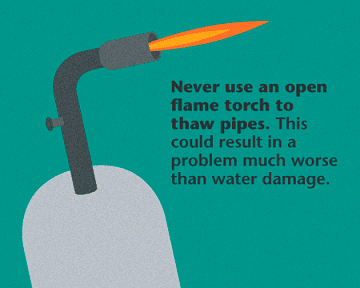A frozen water pipe can be trouble for building owners. That trouble begins when the pipe expands as a result of frozen water. If left undetected, the pipe bursts, spraying water on equipment and furniture. As a result, you suffer a loss and have the added expense of water damage restoration service.
Despite the precautions you may have taken before winter arrived, pipes that are exposed to severe cold weather are always at risk of freezing. These pipes run through poorly insulated areas such as garages, crawl spaces or against exterior walls. How can you tell if you have a problem? Plumbing experts recommend turning each water supply faucet (hot and cold) to ensure there is a steady stream. If the stream is slower than normal or there is no flow, you have a potentially dangerous situation that needs immediate attention.
Once you identify the length of pipe that may be frozen, the American Red Cross recommends the following actions to thaw pipes:
- Wrap a heating pad around the frozen pipe.
- Use an electric hair dryer to warm the area of pipe.
- Direct a space heater at the pipe, but be sure to keep the heater clear of any flammables.
- Wrap pipes in towels that have been soaked in warm water.
Never use an open flame torch to thaw pipes. This could result in a problem much worse than water damage—a massive fire.
If you suspect a frozen pipe in a commercial facility, call a plumbing contractor who has special tools for locating and resolving the issue. If you have concerns about the integrity of your sprinkler system, call a sprinkler contractor. Speak to the professionals about ways to avoid problems in the future by relocating exposed pipes or adding installation where needed.
